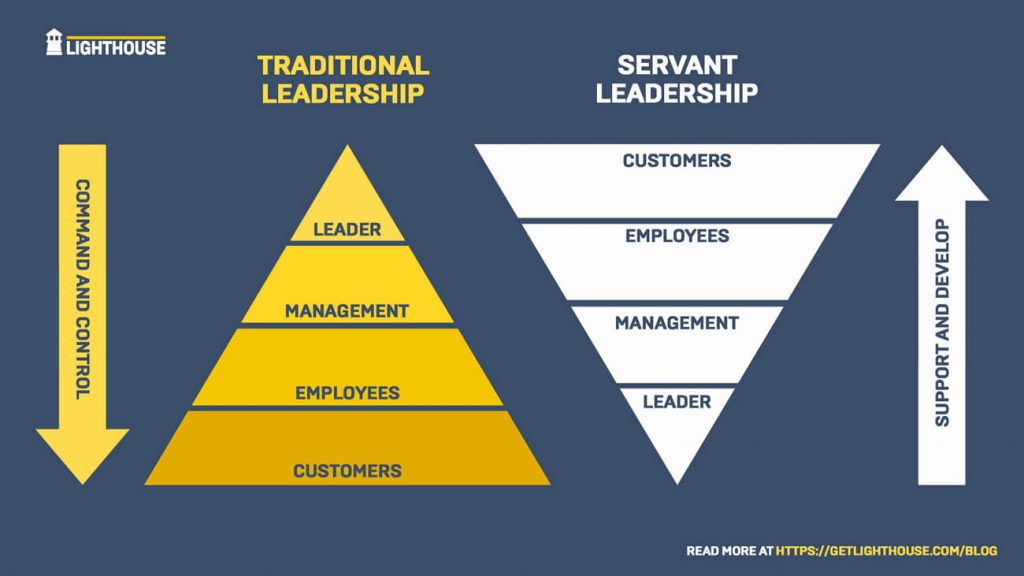What defines great leadership? What makes you a great leader vs. a poor one?
It’s all about the actions you take, and your mindset.
While multiple styles of leadership can work, depending on your situation, one of the ones gaining more prominence is called, “Servant Leadership.”
Whether you’ve heard of it already, or curious what it entails, today we’re here to make it all clear for you.
Servant Leadership?
Coined in 1970 by leadership consultant and author Robert Greenleaf, his concept of “servant leadership” flips the stereotypical leadership model of behaviors and mindset on its head.
Servant leadership focuses on putting employees first and helping team members reach their full potential. Unlike traditional "command-and-control" leadership that relies on authority and commands, servant leadership leads through empathy, support, and genuine care for employees.
The belief is that by taking care of your team, they’ll take care of you and your company’s goals.
Given this leadership style is still talked about over 50 years after Greenleaf first wrote about it, we think there’s something to learn from it. We’re also big fans of any mindset that includes a more empathetic style of leadership, so we knew we wanted to give you a deep dive into this concept.
In this comprehensive guide, we share with you everything you need to know about the philosophy of servant leadership. You'll learn more about its origins, how it works, its benefits and potential drawbacks, and examples of well-known servant leaders. We'll also debunk common myths and provide tips to help you adopt this people-centric leadership approach.
Table of contents
- What is Servant Leadership?
- Real examples of Servant leaders
- How do I put into practice being a servant leader?
- Is Servant Leadership That Good?
What is Servant Leadership?
As we briefly explained above, Servant Leadership is the opposite of traditional leadership. Instead of bossing people around, you focus on really understanding and meeting your team's needs. Then, the belief is that everything else flows from there to ultimately better serve your customers.
This image captures the contrast well here:

Who invented the servant leadership model? How did he come up with it?
Robert K. Greenleaf created Servant leadership when he was inspired after reading a book called, “Journey to the East.” In the book, a character who was a servant proved to be a crucial leader in a group, which was essential to everyone’s survival.
Greenleaf first tried his servant approach to leadership at his job as an executive at AT&T. When he found it worked, he then left it at 49 to become a consultant to evangelize the concept.
He introduced this idea to the world in his essay "The Servant as Leader," published in 1970. Later, he expanded it into a complete book called, “Servant Leadership” published in 1987.
Here’s how servant leadership’s creator, Robert Greenleaf, describes the leadership style:
“The servant-leader is servant first... Becoming a servant-leader begins with the natural feeling that one wants to serve, to serve first. Then conscious choice brings one to aspire to lead. That person is sharply different from one who is leader first...
The difference manifests itself in the care taken by the servant first to make sure that other people's highest priority needs are being served.
The best test, and the most difficult to administer, is this: Do those served grow as persons? Do they, while being served, become healthier, wiser, freer, more autonomous, more likely themselves to become servants?Greenleaf, R. K. (2002). Servant Leadership: A Journey into the Nature of Legitimate Power and Greatness (25th anniversary ed.)
Put simply, Greenleaf believes that if you take care of your team, then they in turn will be better able to succeed in their work, and more likely to also take on the mindset of serving others, too.

Does the servant leadership model actually work?
The idea of putting your team first, so they’ll put the customer first may sound great, but how does it work in practice? And most importantly, does it actually work?
To answer this question, we have gathered some evidence that adopting a servant leadership management style can lead to a positive outcome for your organization. Let's look at some data:
Servant leadership boosts employee performance
Research shows that taking a servant leadership approach can directly improve how well your team members perform their jobs. Researchers at the Prince Sultan University in Saudi Arabia surveyed 233 supervisor-subordinate pairs to look at how servant leadership impacted individual employee performance.
They found servant leadership management style strongly predicted better task performance and organizational citizenship behaviors (helping teammates, volunteering for extra work, promoting the company culture) from subordinates.
The researchers explained it this way:
"Servant leadership strongly predicted affective trust, organizational citizenship behaviors (OCBs), and task performance of subordinates.
…When servant leaders manage to develop quality relationships with their subordinates by inducing cognitive and affective trust, it results in a reciprocal exchange and the extra-role behaviors "
In short, servant leadership leads to greater emotional bonds and trust between leaders and team members. This trust inspires employees to work harder and go beyond expectations.
Servant leadership enhances psychological safety
Psychological safety is the belief that you won't be embarrassed or punished for speaking up with questions, ideas, or concerns. In his book, Serve to Be Great: Leadership Lessons from a Prison, a Monastery, and a Boardroomone, Matt Tanney explains that servant leadership helps with creating psychologically safe work environments. This happens through the strong bonds of trust servant leaders form with their team.
“When employees feel psychologically safe, they engage more with their work and their co-workers. It can impact everything from innovation to retention in an organization.
Servant leaders build trust and forge authentic connections with team members by honing their emotional intelligence and leading with self-awareness, compassion, honesty, and transparency.”
When you show compassion, act with transparency, and demonstrate care for people's well-being, they feel "safe" with you.
Your team knows you have their back. They can be vulnerable without fear of being attacked or mocked.
This safety to take risks and be themselves unlocks great benefits:
- More engagement. People enjoy working more when they feel trusted and respected.
- Better collaboration. Teams brainstorm and problem solve better when they feel psychological safety.
- Increased innovation. Game-changing ideas require the freedom to think big without fear of failure, and the ability to debate and discuss freely..
- Higher retention. People don't quit bosses who make them feel valued and heard.
These are benefits any leader would like to experience.
Servant leadership boosts sales and profits
For those who want the most concrete data, and care most about the bottom line, the final data point on the value of servant leadership is the biggest one.
A study by Vincent Giolito and colleagues looked at 55 stores within one company in France. They found that stores with managers rated highly on servant leadership saw greater growth in sales and profits, even during a crisis:
“…while only 22 of the 55 stores in our sample achieved positive profit growth, 18 of those 22 successful stores had managers rated above average for servant leadership.”
And as they looked deeper, they found:
"Not only is servant leadership good for people management and employee morale – it also has a positive impact on company performance, measured by growth in sales and profit."
It may feel warm and fuzzy to focus on things like employee morale, but nothing proves a point stronger than the impact on the bottom line. The fact is, servant leadership can help your bottom line, and later, we’ll show you examples of when leaders of publicly traded companies saw the same as well.
Real examples of Servant leaders
In addition to studies that show how servant leadership can help you and your company, there are also leaders today you’ll recognize today that practice it, and have gotten the kinds of results you’d love to get, too.
Let's take a look at some leaders who have used servant leadership principles and made a remarkable impact. Their stories show how putting people first can lead to transformation and success:

Cheryl Bachelder — Former CEO, Popeyes Louisiana Kitchen
Ever heard of the book "Dare To Serve"? It's a goldmine for anyone interested in servant leadership. The author, Cheryl Bachelder, was the CEO of Popeyes Louisiana Kitchen.
She took a struggling food chain and turned it into a major success story, all by nurturing a servant leadership culture.
The stock price of Popeyes Louisiana Kitchen was around $10.25 when Bachelder took the CEO role in November 2007. During her 10 year run, she led the company to new heights of success as their stock price soared to $75 per share by the end of her tenure:

How did she do it?
When Bachelder joined in 2007, she realized the company viewed internal and external stakeholders negatively. As a result, Popeyes was struggling with declining sales and low morale.
To address this, Bachelder focused on "serving people well to generate better business results" through a servant leadership approach. She rallied employees around bold goals to revitalize the company.
“Defining the principles of the culture and holding the team accountable to those principles is fundamentally the work and the responsibility of the leader. … Without principles in action, the leader cannot drive superior results—and may, in fact, risk disaster.”
To accomplish this, Bachelder established six principles to transform the culture:
- We are passionate about what we do.
- We listen carefully and learn continuously.
- We are fact-based and planful.
- We coach and develop our people.
- We are personally accountable.
- We value humility.
As she described it, the emphasis was on "we" not "I." Treating people with dignity allowed everyone to feel purpose.
As a result of Bachelder's servant leadership approach, Popeyes' restaurant sales rose 45%, profits doubled, and stock price tripled. Her story shows the power of leading with empathy, vision and courage.

Herb Kelleher — Cofounder and CEO (former), Southwest Airlines
This quote best demonstrates the leadership philosophy of Herb Kelleher, which is very servant leadership-like:
"Your employees come first. And if you treat your employees right, guess what? Your customers come back, and that makes your shareholders happy. Start with employees and the rest follows from that."
Kelleher modeled Southwest Airlines after Pacific Southwest Airlines, a successful short-haul carrier in California. He wanted to create affordable flights between Texas cities, such as Dallas, Houston, and San Antonio.
Though an attorney by profession, Kelleher persevered for four years fighting legal battles to get Southwest off the ground, believing he was defending free enterprise. He and his partners kept operations simple – single aircraft type (it was Boeing 737), point-to-point routes, fast plane turns.
Kelleher believed a leader's most important role is to build a strong culture by hiring the right people. At Southwest he created a “culture of commitment” devoted to employee happiness, which he believed would lead to happy customers. This was quite the differentiator in the commoditized airline industry

Employee happiness and customer experience were top priorities for Kelleher. He wanted passengers to feel that they had one of the most enjoyable flights possible. This approach paid off. As noted in Fortune, Southwest maintained an incredible streak of over 40 consecutive profitable years, even continuing this legacy after he stepped down as CEO in 2001. Kelleher left an enduring legacy of how servant leadership principles can grow a business, and the success of the business

Satya Nadella — CEO, Microsoft
When you think of warm, employee-friendly cultures, Microsoft may not be the first company you think of. Their history of workaholic, brutal work of Bill Gates, and the over-exuberant, sales-driven approach of Steve Ballmer don’t bring servant leadership to mind.
However, in 2014 Satya Nadella took the reins of Microsoft and dramatically changed the culture and the company’s trajectory by taking it in a very different cultural direction.
And what was the result of the new vision? In short, after 4 years, the value of Microsoft shares tripled.

The success of Satya
When Satya Nadella took over as CEO of Microsoft in 2014, he made listening to employees at all levels a priority. According to Forbes, he spent his first year as CEO engaging with employees across the company. This helped him shift the culture toward innovation, inclusion, and engagement.
In one defining statement, Nadella said: "We need to believe in the ability of people to grow and develop. We need to build a growth mindset organization." He realized the power of coaching and support, and made it a cornerstone of Microsoft's "Model, Coach, Care" framework.
Nadella made it clear that he expected every single employee at Microsoft to embrace a leadership role. But he soon realized there was an issue — he found that there were over 100 different definitions of "leadership" depending on where you worked in the massive company.
To address this, Nadella brought together a diverse team of leaders and asked them to come to a consensus on a simplified, unified meaning of what leadership means at Microsoft.
In an interview with Inc. he outlined three key things great leaders should create:
- Clarity — in uncertain times, leaders must bring clarity to the path forward. As Nadella stated, "Your ability to come into an uncertain time and an uncertain future and bring about clarity is key."
- Energy — leaders must inspire their teammates and create contagious enthusiasm. Nadella cautioned against those who say "everything around me is terrible" rather than energizing their team. He noted that "There is no simple thing that is always under your control, so the idea is that you have got to create energy all around you."
- Success, no matter the circumstances — great leaders deliver results despite constraints. They don't make excuses but find ways to succeed in an "overconstrained space.
Nadella’s approach to listening, combined with encouraging leaders to bring positive energy to their teams is the kind of servant leadership that helps make it easier for employees to also want to bring positive energy and empathy to customers.
Most importantly, across these leaders — Cheryl Bachelder, Herb Kelleher, and Satya Nadella — show us that true leadership isn't just about charts and graphs; it's about caring for your people, empowering them, listening, and bringing positive energy.
How do I put into practice being a servant leader?
Now that we’ve shown you how servant leadership can improve your bottom line, and how some well known leaders drove extraordinary results, let’s take a look at how you can start to be a servant leader.
The first step to becoming a servant leader is to understand is that you have to let go of your ego. You have to stop worrying about control and status. However, in exchange for that sacrifice, what you get in return is a team fully committed and ready to rise to your biggest challenges.
So what does it look like day-to-day to be a servant leader? Let’s take a look at some key practices.
Listen and try to understand your team
As we learned from Satya Nadella, servant leaders make listening a priority. Leadership consultant Ken Blanchard echoes this when he explains:
"One of the key elements of being a trusted servant leader is to listen more than you talk. People want to know they can give feedback or share opinions and not get slammed."
This starts with taking time to get to know your team members personally and what matters to them outside of work. Building rapport is foundational to a strong connection to your team members.
However, listening is more than talking about hobbies, family, and interests. You need to regularly solicit their feedback and ideas in one-on-one meetings and team discussions. Your active listening to them, regardless of the topic, demonstrates respect for them. It builds trust and community, because they feel heard and part of your team on the deepest levels.
To become a servant leader, take time each week to listen to your team without distractions. Turn off Slack, let those notifications wait, and be truly for discussions with them. Dive deeper into their needs and find out if they have any challenges you can support them with. Do not interrupt or rush to give advice — focus on understanding first.
Listening is fundamental to good leadership and a central, starting point for practicing servant leadership. To learn more about mastering this approach, start with these posts:
- Learn how to build rapport with anyone with over 100 ideas in our post.
- Become a more effective listener by following these steps.
- Find out how you can get more feedback from your team here.
Grow your team members in the right ways
As a servant leader, you need to focus on developing your people. As researchers Russell and Stone reported in the Leadership & Organization Development Journal, servant leaders exhibit behaviors like "encouragement, teaching, and delegation." This means providing clear expectations, along with the tools and training for your team members to each uniquely excel.
However, true growth only comes when you grant your team the freedom to take some risks and develop new skills they previously lacked. As we learned from Dan Pink’s work in Drive, you need to give your team members some level of Autonomy to learn and grow, as well as coach them to develop Mastery in their roles.
To accomplish this, teach your team members new skills that align with their interests (you are asking your team members what they enjoy most and are curious about, right?). Delegate projects that let them own outcomes and work in areas that motivate them.
This is a big area of learning for many managers, so don’t feel bad if you’re not sure where to begin. We have you covered:
- Start by learning about task relevant maturity, which will help you gauge where your team member’s skills stand and how to best support them.
- If you haven’t already had conversations with your team about how they want to grow, then start with one of these 3 approaches to helping them achieve their goals
- And even if promotions aren’t possible you can still help your team grow.
Confront issues with compassion and stand up for your team
When issues arise, servant leaders approach them with empathy, focusing on the problem, not attacking people. That means listening before judging, and focusing on outcomes and solutions, not blame and criticism.
Leadership author Ken Blanchard highlights that it’s important for the leader to start a conversation and check in on how your people are doing to detect issues when they’re easier to resolve:
“Be where your people are. It's not about you, it's about them. Have a conversation. Check in on how your people are doing.
…Effective leadership is about we rather than me.”
By focusing on your team, and checking in regularly, you can create a culture of problem solving and care.

Assume positive intent.
When issues arise, avoid jumping to conclusions or laying blame on your teammates without context. Patience and empathy are your two best friends when resolving issues. Aggression and accusations won't help, as that's a direct way to create a toxic culture and build barriers between you and your team member.
When an issue comes up that negatively impacts your teammates, own it together and collaborate to find a solution. It’s important to make it clear that you don't see problems as a personal failing, and that you are open to working together on improving things.
Being a good servant leader isn’t just about navigating the good times. It’s also about how you handle challenges. To help you handle those situations, review these posts:
- Learn how to step by step improve underperformers in a way that gives them a real chance.
- In a crisis, your team can be part of the solution, not just people you worry about: Ask them these questions to engage them in solving the problem.
- Often, the root of problems are deeper in your organization. Learn how to get feedback through skip level 1 on 1s here.
Express gratitude and recognize progress
Servant leaders show appreciation to their teams for hard work and give credit for creating positive results.
As we learned from Russel and Stone’s article in the Leadership & Organization Development Journal servant leaders demonstrate "appreciation of others" as one of the functional attributes of servant leadership.
Remember to take the time to recognize both small wins and significant milestones. They let your team members know you care, and motivate them to continue to perform at the same level.
There’s a lot more to giving great praise and recognition, which is why we have many posts specifically dedicated to the topic to help you:
- Learn over 21 great ways to be more positive and recognize your team
- Learn 9 effective ways to give praise depending on your time and budget available.

Is Servant Leadership That Good?
So far we’ve focused on what makes servant leadership an effective approach. We’ve shared how it’s helped other leaders, the research that supports it, and even how you can practice it.
Yet, we’d be missing an important aspect if we didn’t consider the downsides and challenges of servant leadership. Here’s a few of the most valid critiques and challenges you may here from skeptics.
This is not the easy path.
Firstly, being a servant leader is not easy. It takes time and effort; it's an investment.
All of the habits and behaviors we outlined in the prior section require time and commitment from you to put them into practice. Consistency in practicing them is a key part of making them work.
That means doing things like:
- Making time on your calendar to have regular 1 on 1s with your team.
- Putting in the effort to prepare for those meetings, and reflecting on what your team brings up.
- Keeping your promises and commitments so your actions, as well as your words, demonstrate your embracing of servant leadership.
These things are all easier said than done, but as the prior data and stories we shared show, the payoff makes it worth it.
Here’s a few more challenges and critiques to consider as you head down the road of becoming a servant leader.
Resistance from Those Who Got Used to Classic Leadership
A key disadvantage of the servant leadership model is that you may experience resistance from some of your team members. Some employees are used to the classic leadership style where they’re told what to do and can comfortably stay in the same role unchanged.
Your team members who aren’t used to being challenged, pushed to grow, and asked to think independently may be skeptical and resistant to your change in leadership style. They were perfectly comfortable coasting in a command and control leadership approach.
In those cases, your change to servant leadership can be seen as quite unwelcome.
Unfortunately, changing their hearts and minds won’t happen overnight. You’ll have to ease them into becoming more autonomous and growth oriented.
However, if they see some of their peers thrive, and you consistently demonstrate your commitment to this new approach, they are likely to warm to it. And even if they don’t, it will still work out for you; they’re likely to move onto another company where less is asked of employees, and you can hire someone who would *love* to have a manager that supports and empowers them.
Difficulty with Directness
When you embrace a servant leadership mindset, it may become more difficult to be direct with your team. When you spend so much time considering the needs, interests, and challenges of your team, pushing back on them can become harder.
It’s important to recognize that supporting your team members is *not* in conflict with meeting your company’s goals and needs. In fact, the art of management is about aligning the two, which you can accomplish by:
- Helping your team members improve their performance
- Learning the strengths of each team member and focusing them on how they can help achieve the goals of your team and company
- Showing you care so that any feedback is in service of their improvement, not a negative reflection on who they are as a person.
Your focus on building relationships as servant leader can make it challenging to deliver direct feedback or make difficult decisions that negatively impact team members. However, if you do so coming from a place of compassion and understanding, you may be surprised how well your team members may take the feedback you’re nervous about giving.
Perceived Weakness
The last disadvantage of this model is one that creates a caricature of what servant leadership is really all about. It’s the idea that caring is somehow a weakness, and that tbeing empathetic and collaborative is an inferior way to work.
Hopefully, the data we share has convinced you this is a misnomer; done well, servant leadership delivers great results that are anything but weak as the success of Microsoft, Southwest, and Popeye’s shows us.
Importantly, you must recognize that you can be compassionate and strong. One does not contradict the other. A compassionate leader can also have high standards. A caring leader can still set great expectations, and a coach can still demand and help create excellence.
While there is a cartoon version of servant leadership that could be considered weak, real servant leadership is anything but that.
So What are The Pros and Cons of Servant Leadership?
As you can see, there are trade-offs to this approach, but in the end, you still will come out ahead if you embrace servant leadership with a good team.
Here’s a good summary of the key points from today’s post:
| Pros of Servant Leadership | Cons of Servant Leadership |
|---|---|
| Boosts employee performance | Time and effort intensive |
| Enhances psychological safety | Requires balancing standards and compassion |
| Boosts sales and profits | May face resistance to change |
| Creates great team morale and spirit | Perceived weakness by those unfamiliar |
Are you Ready to Become a Servant Leader?
Becoming a servant leader is not the easy path. No, simply giving orders and having everyone do everything “your way” is a lot simpler. Yet, the more rewarding, and successful approach is to embrace servant leadership.
Servant leaders know that helping people isn't just a side mission — it's a pursuit worthy of their time and effort. They understand that true leadership isn't about barking orders — it's about, guiding, supporting, and leading others in a compassionate and caring way.
When you put your team first, they put customers first, and the rest takes care of itself.
Are you ready to take on the challenge of servant leadership?





